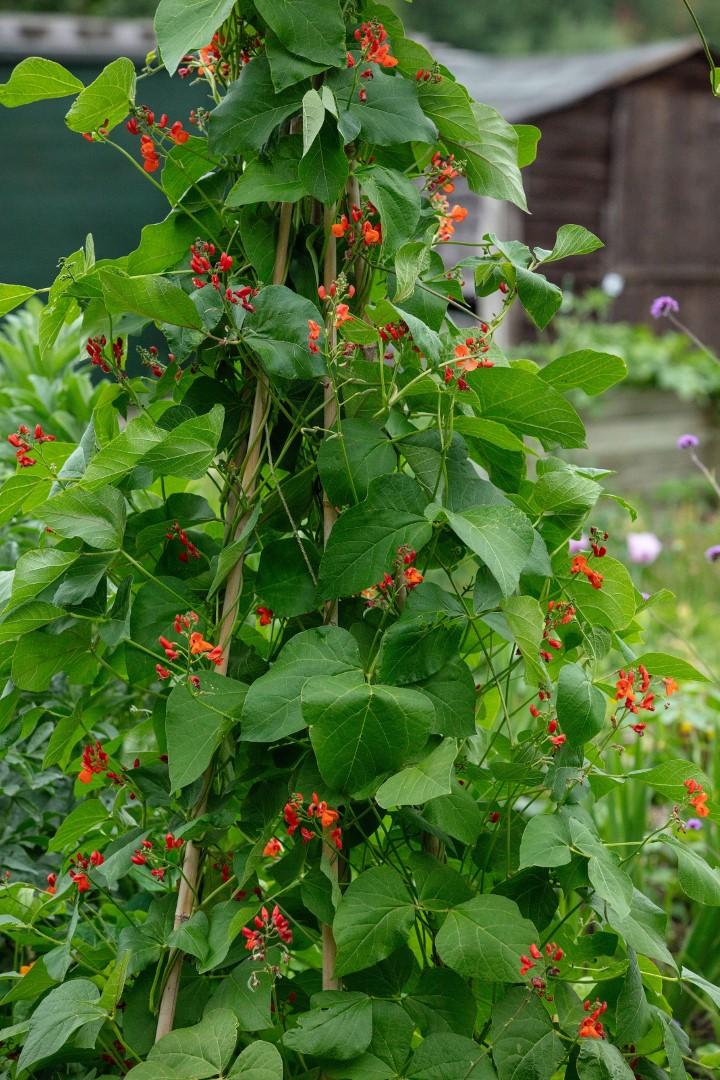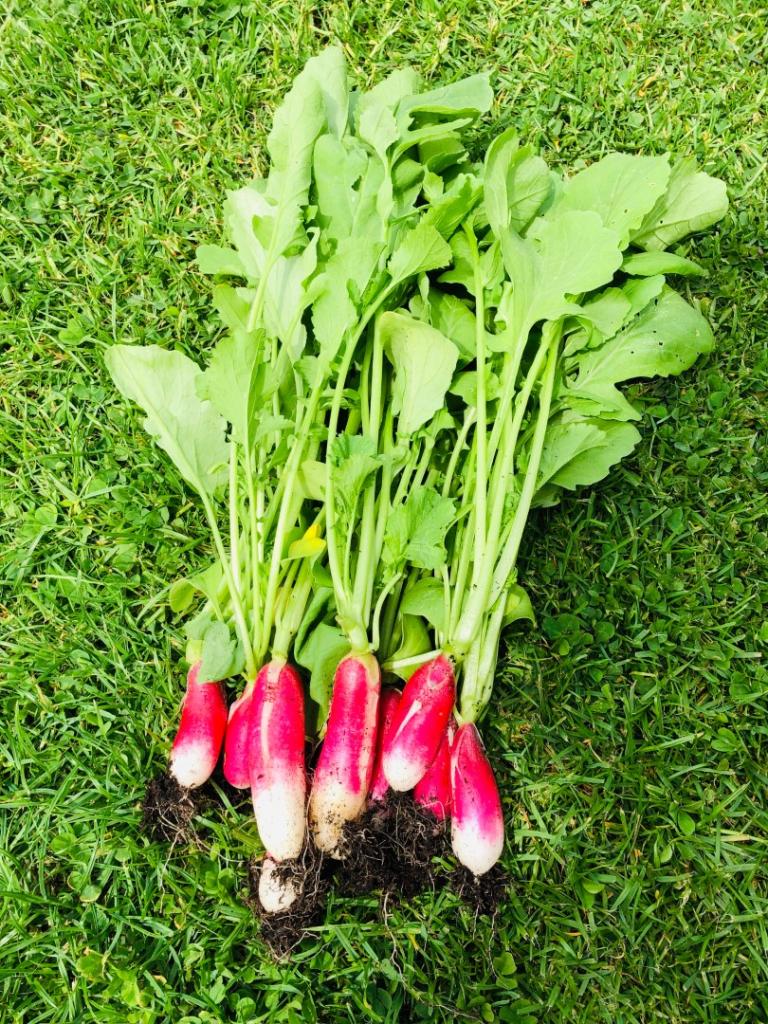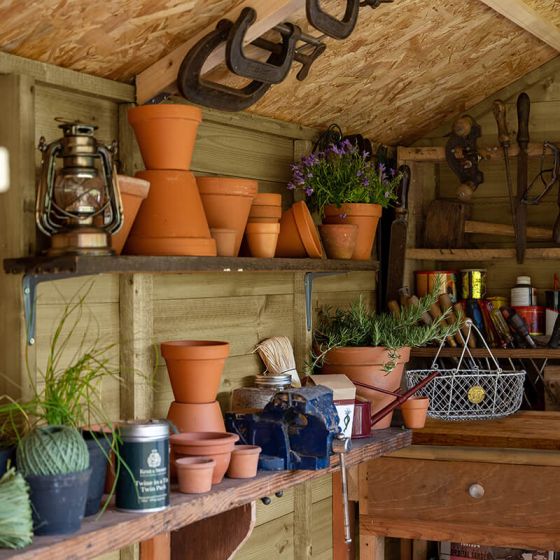June Hints & Tips
June is the beginning of summer and you should now start to see the results of all the work done earlier in the year.
So it’s time to really enjoy using your garden. But there are still some essential jobs that need carrying out if the summer is going to be a brilliant and colourful success.
So don’t rest completely on your laurels!

What vegetables to plant in June
As the summer months arrive in June, the promise of long days and warm weather means this is one of the busiest times in your vegetable garden. But put in the hard work now and you’ll continue to see the benefits. If you haven’t already, sow the following vegetables in June:
- Dwarf bean
- Runner bean
- Beetroot
- Cabbage
- Chinese cabbage
- Carrot
- Cauliflower
- Chard
- Cucumber
- Lettuce
- Peas
- Radish
- Rocket
- Spring onion
- Swede
- Spinach
- Sweetcorn

What vegetables to harvest in June
If you’ve already been busy in your vegetable garden and you have plenty of crops growing, you’ll be in for a treat in June. The vegetables usually ready to harvest in June are:
- Asparagus
- Beetroot
- Broccoli
- Carrot
- Cauliflower
- Garlic
- Lettuce
- Peas
- Potato
- Radish
- Rocket
- Samphire
- Spinach
- Spring onion
- Tomato
- Turnip
Things to do this month
- Make some time to sit and enjoy your garden.
- Fire up the barbecue and enjoy some al fresco dining whenever the weather allows.
- Plant out all your bedding and other half-hardy summer-flowering plants – as soon as the fear of frosts and cold nights has passed.
- Turn the compost in your bin to keep it well aerated.
- Water container plants regularly - probably daily, depending on the weather.
- Check plants regularly to see if they need watering. If they do, give them a thorough soaking.
- Feed wild birds daily with suitable bird food. They rely on us for food all year round.
- Keep secateurs and hoe blades sharp, so they cut well. Always have a tool sharpener handy.
- Remove algae and blanket weed from ponds to stop them taking over and choking them.
- Keep bird baths topped up with water as birds need a daily supply of fresh water.
- Clean tools with an oily rag after use to keep them clean, looking good and prevent rusting.
- Check plants regularly for pests and diseases and deal with them before they get out of control.
From the potting shed...

Our monthly gardening newsletter, written by our Great Amwell plant department colleague, Chris Milborne.
We’re in the first month of summer and the garden has really come into its own. Although I enjoy the changing seasons in the garden…at this time of the year, I wish the June garden would last longer. It’s bursting with growth; lovely fresh green foliage – really lush growth from this spring’s wet weather. Lawns are very green, flowers from late spring and early summer plants are thriving. We have the scent and flowers of roses, the herbaceous plants look wonderful and the first tasty fresh vegetables are ready for harvesting.
The warmer weather and longer days gives you the opportunity to just sit back, relax and appreciate the beauty of plants, nature at its best and to take a moment to simply enjoy the results of all your hard work – but gardeners never seem to sit still for long! There are weeds to deal with, there’s sewing, growing and harvesting to be done in the vegetable plot. In the flowering border, you can add late season flowering plants, such as herbaceous perennials to replace earlier flowering spring plants. Tender perennials and annuals, like colourful salvia and cosmos can be added for some extra interest, plus pot growth dahlias to fill any gaps and for flowers all summer long to fill gaps where bulbs or earlier spring plants have finished.
If you didn’t plant up summer containers in May, there’s still time now – perhaps it’s even easier with plants in full colour and larger plants to provide instant impact.
Glorious Roses
Every garden should grow at least a couple of roses – they are easy to grow and can tolerate a wide range of conditions, provided they are well fed and preferably in a sunny spot. For best results, the soil needs to be enhanced with some well-rotted manure, garden compost or bagged soil improver.
Roses come in many shapes and sizes, producing flowers; single, semi-double and double. They have wide ranging colours, some with superb scent. Roses fill a gap in any garden, whether it be climbers and ramblers, old and modern shrub roses, smaller patio roses - useful for growing in containers. Types such as, rosa rugosa are even useful when creating a mixed hedge.
Roses are steeped in history, with rosa gallica grown by the Ancient Greeks and Romans. Other varieties come to the UK, probably with the crusaders from Damascus and by the end of the 15th century, 14 different varies of roses were being grown in the country. But it was during the late 15th with the arrival of the China rose that gardeners established ways to breed new roses and hybrid perpetuals were developed, leading to formal rose borders. During the 19th century, hybrid tea roses, popular today, were developed by crossing tea roses with hybrid perpetuals. Even today, new types are introduced each year, with flower scent and disease resistance being particularly important.
Roses in smaller gardens can be planted together with shrubs and herbaceous plants such as lavender Hidcote or vera, ceanothus repens, cistus, spirea, nepeta, hardy geraniums, late flowering rudbeckia ‘goldstrum’, campanula, lactiflora and salvia nemerosa. Growing clematis with climbing roses or grown on obelisks can help provide height between roses. Apparently, chives help to prevent black spot, garlic repels aphids and the scent of silver leaf shrub santolina deters pests. With roses, good plant hygiene such as regular dead heading and clearing away any dead petals and leaves is essential to prevent back spot, a waterborne disease.
Herbaceous Plants
Herbaceous perennials are some of our favourite garden plants, found in all heights and a varied range of flower sizes and colours and used throughout the garden. Whether used together in a herbaceous border around water features, shady areas, taller perennials planted with grasses. Plants with good foliage or foliage colour used - tub and container planting schemes, silver, gold, purple leaved varieties, house with good flowers or interesting seed leads are good for flower arranging.
June Highlights
Philadelphus or mock orange, as it is commonly known, is a popular shrub with fragrant white flowers, available in many varieties. Philadelphus ‘Belle Etoile’ has reddish staining at the centre of single white flowers and a wonderful fragrance, and the more compact ‘Monteau Hermine’ produces honey fragranced double flowers. Philadelphus coronarius ‘Aureus’ has golden yellow leaves. Deutzia is a hardy deciduous shrub that thrives in most soils and is ideal for sunny or slightly shaded positions – it flowers white to tinted pink, has arching stems and interesting rich brown bark in winter.
Ceanothus has mauve, blue fluffy flowers – the Californian lilac glossy green leaves enjoy a well-drained, sunny location. The flowers attract bees and butterflies – if leaves turn greeny-yellow, you should use an ericaceous liquid feed.
Clematis are a wide range of flowering hybrids, giving height to the garden, covering walls, fencing, pergolas or obelisks. They produce an abundance of flowers in pinks, purples, whites, mauves and lavender. They need moisture retentive soil, rich in organic matter, with roots in the shade and growing up in good light.
Lonicera or honeysuckle include a large range of species; some evergreen or semi-evergreen and produce an abundance of scented flowers.
Thalictrum – A herbaceous plant that’s easy to grow, very adaptable in the garden, in sun or shade. Theis plants has lacy foliage and bright springs or purple-pink flowers.
For a wonderful ground cover plant, look no further than handy geranium or cranesbill. Some hardy geraniums are shad loving, so ideal for growing under roses or deciduous shrubs. In autumn, their foliage turns a rich red – an added bonus to brighten the autumn days.
Hostas are another highlight, with their large leaves – green and steely blue, and some with large, variegated leaves, plus spikes of trumpet shapes lilac flowers. I have found that blue, green and gold glaucous varieties are less prone to slug damage. All varieties of hostas like to be grown in lightshade and require moist soil with added organic compost. The golden variegated leaved varieties are ideal for growing under trees and shrubs. The look spectacular with acers – the bright leaves add colour to the semi-shad. Plant steely-blue hostas with other plants, such as iris siberica around ponds – the leaves look stunning reflected in the water. Hostas are good for tubs and containers if slugs and snails are a problem.
Another group of plants that enjoys that difficult shady position is the fern; They transform these dark corners, arching fronds in many shades of green. Evergreen ferns brighten up the garden in winter. Ferns are an ancient group of plants, first appearing some 400 million years ago and were very popular in Victorian and Edwardian periods. Many ferns grow well in dappled shade, beneath deciduous trees, or in shady spots, or rock gardens – especially spleenworts, which grows out horizontally in gaps between rocks. For impact in the right conditions, is the stunning tree fern, Dicksonia antarctica, although it does require protection in winter months.
Some other June highlights include: alstroemerias, crinodendron, cotoneaster, spirea (with wonderful foliage colours), hebes and sambucus ‘black lace.
Summer Containers
Plant up tub, containers and hedging baskets for summer colours and interest – this instantly brightens up patios or can be used to fill gaps in flower beds and borders. For this, plant up containers with a mix of herbaceous perennials, grasses and summer bedding. Place these in any gaps to provide instant colour. When finished in the autumn, replace with bulbs for spring, plus other autumnal or winter interest plants. In June, summer bedding plants full of flowers instantly add colour to a dull patio space and the flowers last right up until the first frosts. It is important to dead head spent flowers, and you should regularly water and feed your plants to maintain an impressive display. A few plants that are easy to maintain include: petunias, the smaller flowered calibrachoas, pelargoniums, verbena, nemesia, as well as: bacopa, cosmos, sunflowers and dahliettas – the dwarf bedding dahlia. Agapanthus with large round balls of blue or white flowers is good for growing in tubs and containers. For a shadier area, try pots of fuchsias, begonias (upright and trailing with its interesting foliage) and impatiens, or the New Guinea hybrid – All are very reliable and free-flowering.
Plant up containers of your favourite herbs by the BBQ area so they are at hand when you are cooking. Herbs also make for an attractive in window boxes or hanging baskets. When planting up your summer containers, I have found the best results when mixing multipurpose compost with John Innes compost no.3 – this increases nutrient holding conditions, also helping with water retention.
Sow biennials – these are flowers that grow one year and flower and set seed the next. These plants are really useful for filling gaps in the garden borders. Many of these plants flower after the very early spring flowers finish and before the summer ones start flowering. These include foxgloves, primroses, wallflowers, sweet Williams, canterbury bells and verbena bonariensis. I sow these in a small nursery bed I have in the garden and keep them watered, fed and weeded – just watch out for slugs and snails, as they are particularly bad this year, after the recent warm weather.
Lawns - Mow the lawn regularly. Personally, I keep neat edges, which makes the garden seem a lot tidier. To create a wildlife friendly area that attracts pollinating insects, use a part of a flower border to sow yarrow, mallow, meadow cranesbill, corn marigold, cornflower, ragged ribbon, forget me nots, dill, borage, coriander and basil- All of these make for a natural, colourful display!
Water adds life to a garden, whether it is the splashing sound of a water feature (very relaxing!) or the reflections or surroundings on the water surface. Water adds an extra dimension and has been an important of gardening for thousands of years. There are many choices, ranging from a formal pond or a more natural-looking informal pond, which is wildlife-friendly and has some shallow sections, allowing a range of plants to be grown around the margins. Evena a small garden can have a water feature, using a half barrel or a large plastic container. For best results, they need a sunny, open position, preferably not under trees.
Vegetables, Fruits and Herbs
In June, plenty of delicious produce is in season; the first summer fruits, early potatoes at the ned of the month, as well as lettuce, rocket, radishes and Swiss chard. As these crops finish, clear the space, feed the soil with an organic fertiliser, then sow or plant your next crop. This could be tomato, aubergine, marrow, courgette, squash, sweetcorn or pepper. Also think ahead the autumn and winter and plant winter kale, sprouts and leeks and sow seeds of lettuce, rocket, spring onions, radish, peas, carrots beetroot, turnip and swede, as well as Chinese cabbage, pak choi and kohl rabi, which is tasty and easy to grow. When planting tomatoes, grow basil and French marigolds next to them, as they help to repel whiteflies. French and runner beans can still be sown straight into the ground. Runner beans can be grown as a bush – plant them in a single row when they reach 60cm (2ft) in height, pinch out the growing tips - the plants become bushy and the bean pods are not so long, but provide a good crop if you don’t have any canes or stakes.
Marrows, courgettes and water squashes are now ready to plant – they are gross feeders and can even be planted on the top of a well-rotted down compost heap. When planting in the soil, incorporate plenty of organic matter, for watering use a water bottle inverted with the base removed, plunged into the soil next to the plants – this gets water to the roots, while keeping the neck of the plant dry, as this helps to prevent stem rot. In gardens with limited space, grow decorative vegetable varieties that look stunning mixed with flowering plants, these include colourful climbing French beans grown on wigwams, mixes of red and green frilly leaned lettuce, rainbow-coloured stalks of chard, plus colourful leaves of beetroot and furry leaves of carrots with chives making an attractive edging. Having a mixture of plants helps against pests and diseases.
- Keep your brassicas protected against pigeons.
- Keep and eye out for the asparagus beetle – it is easy to spot, are it’s bright and shiny. It needs to be removed before it has a chance to damage foliage.
Fruit
- Trim off strawberry runners, as these take energy from the plant.
- Trim plum, apple and pear if they are growing too close together, although small fruits very often fall naturally – this is known as the ‘June drop’.
- Put up pheromone trapp s to protect plums and apples against codling moths.
- Protect strawberries and soft fruits from birds.
I have found that ‘Strulch’ mineralised straw works well around strawberries – protecting the plants from slugs and snails, and as a mulch it also retains soi moisture and breaks down to improve the soil.
Herbs
- Plant basil, sow parsley and coriander. Sow a few seeds every two weeks for continual cropping, as easily goes to seed in dry weather.
- Give mint a trim to produce new growth.
- Plant up a new area or tub of shrubby herbs such as thyme, sage, rosemary, bay or lavender.
Houseplants
Even if you don’t have a garden or outside space, you can still garden indoors. Houseplants are hugely popular, with a wide range of interesting and exotic lush foliage. Anthuriums produce incredible flowers. These are houseplants for all rooms of the home, whether a shady space or a sunny windowsill. Mamy houseplants also improve air quality.
Here are a few plants for inspiration: Streptocarpus, maranta, strelitzia, alocasia, calathea and philodendron.
- Water and feed houseplants regularly and repot if roots pot bound.
Tip and Ideas
- Cut back and dead head oriental poppies after flowering produces new foliage and possibly new flowers. Mulching and feeding helps with new growth.
- Remove faded flowers in rhododendrons.
- Tidy up perennials after flowering.
- Lift and divide overcrowded bulbs after they have finished flowering.
- Keep on top of weeds to prevent them from spreading and seeding themselves.
- Keep tubs, containers and hanging baskets watered and dead-head and feed flowers every two weeks.
- Visit gardens open to the public for inspiration and ideas for colours themes and plants combinations to try at home.
Take time to enjoy the June garden; the beauty and fragrance of roses, the smell of freshly mown law, the distinctive scent of tomatoes grown in the greenhouse – all to savour!


